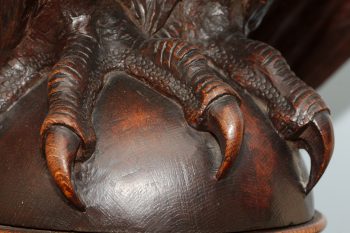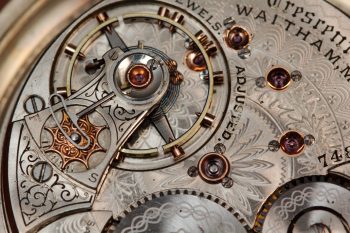Back on Wednesday, January 23, 2013 I posted a photo titled “Lectern Eagle’s Talons” which was a portion of a wooden lectern carved in the shape of an eagle. This is the head of the eagle, which unfortunately has a chipped beak. There is also a large crack across the breast of the bird, but that adds character more than anything. Otherwise, it’s in pretty good shape. There was, at one time, a brass plaque (I’m assuming brass) which probably said who paid for the lectern or something of that sort. There really needs to be a small set of steps behind this, so you can get up high enough to read from it, as the whole things is well over six feel tall.
Tagged With: Antique
Edison Phonograph Records
Among the things brought out of Cathy’s mom’s house were a box of Edison Phonograph cylinder records. There was also a record player. David took that but couldn’t get these into the car, so they will stay here until next time. The two cases shown here are slightly different from one another. On the left is one that says Edison Gold Moulded Record and on the right, simply Edison Record. I would normally assume that the Gold Moulded one is newer than the plainer one, but the dates on them (which are 1906 and 1908 respectively) don’t support that. The disks inside almost certainly don’t match the sleeves. The disks in them, which may or may not be those originally in these sleeves, are Rock of Ages, by the Edison Dixie Quartet and Kitty O’Neill Medley of Reels (violin).
Lectern Eagle’s Talons
I’ve posted pictures of this eagle lectern twice before, once on Wednesday, January 23, 2013 and then again on Thursday, January 04, 2018. The first of those is quite similar to this picture, I’m afraid, but it was long enough ago that I’m doubtful that many who are following me now will remember. The other, a picture of the body of the eagle, is more recent. I also took a few pictures of what we assume was an award that was given to my great uncle Ralph. At least it has a brass plaque on the front with his name on it. It doesn’t say what it was for and it may have been some sort of retirement memento. We also are not sure what it is. It appears to be an electronic tuning fork, but we don’t really know. I’ve been meaning to fiddle around with it and see what I can make it do. But as a photograph, it just wasn’t interesting enough so you get a repeat of the wooden eagle talons.
Black Silk Stove Polish
How often do you polish your stove? Here’s what you need. I’m pretty glad that I don’t have to cook on a wood stove or in a wood fired oven. That being said, there’s something nice about a wood oven in a large, country kitchen. I’m not sure that I’d appreciate it so much if I had to polish it, though. Note that this product has a warning on the side that says, “CAUTION: This polish contains naphtha, unsafe when exposed to heat or fire.” That’s certainly a worthwhile caution. Make sure the stove is cool before using.
Here’s an interesting exercise. Can you name three words that are pronounced differently when they are capitalized as a proper noun? One, obviously, is polish/Polish, with the capitalized version being the adjective related to or the language of Poland. I know of two other such words.
Six Old Cameras
I don’t want to get into a debate about nature verses nurture but photography seems to be a family trait in my family. I knew my mom’s father took a lot of pictures. My parents and brothers got the bug, whether through exposure (pun intended) or a natural propensity. The six cameras show here belonged to family members, although a couple of them I know nothing about.
The camera on the right, with the red bellows, is a Kodak camera (model unknown) which belonged to my (paternal) great uncle Ralph. We have some prints (and some negatives) from this camera taken during his time at Oxford and travels through Europe, Egypt, and Palestine between 1910 and 1913. Sadly, it’s lost most of the leather covering, although I do have the very worn leather case that the camera is stored in.
The Speed Graphic, on the left, belonged to my (maternal) grandfather. I’ve used it from time to time, although it’s a lot of work. Once, when we lived in Alaska, I took multiple exposures on a single piece of film during the Independence Day fireworks display over Juneau. My father-in-law had one of these, as well, and used it in the 1950s until he recognized the advantages of speed to be had with a 35mm SLR.
There is a Univex Mercury II, which is a half-frame camera. That’s the one with the semi-circular bit on top, which made room for the circular, rotary shutter. We have quite a few slides from that, taken in the late 1940s by my grandfather. It uses a standard 35mm film canister but the images are only 18×24mm.
I don’t know much about the other three, in terms of who owned them or where they came from. They were found in basements as we cleaned out the two parental houses. There is a Bolsey Model B2 (1949 to 1956), a Spartus “35” (made by Herold Products in the late 1940s), and another folding camera, simply labeled Vario, which refers to the leaf shutter, not the camera as a whole.
I have a few more, including a panorama camera made by Eastman Kodak between 1899-1928. That’s to say nothing of the various 35mm cameras I have accumulated over the years. None of them are worth very much and almost none of them are in anything close to excellent condition.
Waltham Crescent Street Watch
We got this watch out of the safe deposit box recently to show Cathy’s cousin and his wife. It belonged to Cathy’s grandfather, Benje’s great grandfather. It was made by the Waltham Watch Company and is a Model 1892. This is the second version of the model, with the serial number next to the barrel bridge. It’s not in perfect condition but it’s still very nice and we keep it in the safe as much to keep it from being knocked around as anything else. I believe this watch was manufactured in or around 1896, based on the serial number. Because it was made as early as that, when D. B. was only 12 years old, it may have belonged to his father before him or of course he could have bought it used.
Opera Glasses
I don’t know for sure but I think these old opera glasses belonged to my Uncle Ralph and his wife, Aunt Florence. Technically my great uncle and aunt, because he was my grandfather’s brother. Assuming that’s where they came from, I have to assume also that they went to the theatre from time to time. I can’t say that I knew them well. They lived in New Jersey and he died when I was only ten years old. He grew up in the west, having been born in what is now a ghost town in a mining area of Nevada. After earning an undergraduate degree in Utah, he went to St Johns College in Oxford as a Rhodes Scholar where he earned a B.A. degree and a year later a B.Sc. degree.







